“Eat local.” You’ve heard the phrase a billion times. It’s the guiding principle of the farm-to-fork movement, nudging us away from the Industrial Food Complex and toward our neighborhood farms.
But there’s something even more local than a ranch down the road: the orange tree in your front yard. Rather than squander our paychecks at the grocery store, why not pick the fruits and berries that surround us? This is the dead-simple concept behind urban foraging, and a growing group of volunteers, foodies and eco-enthusiasts are turning Sacramento into what could be called, arguably, the “Tree-to-Fork Capital of America.”
“Sacramento is just a giant citrus orchard. There are citrus trees everywhere. But almost all of it falls on the ground and ends up in the garbage can,” says Dominic Allamano, who works at Soil Born Farms as the coordinator of Harvest Sacramento, a volunteer-powered organization that gleans unwanted fruit and delivers it to food banks. Blackberries, cherries, apples, plums — they’re dropping from branches as you read this article. (This is part of the larger story of waste: according to a 2012 study, the United States squanders $165 billion of food each year.)
“There are profound nutritional needs all around us, but our culture’s default setting — commerce — doesn’t know how to connect the two,” says Allamano, who studied economics in college and speaks a bit like your cool Intro to Philosophy professor. “Urban harvesting is trying to repair that relationship.”
Urban foraging matters because our nation’s — and our region’s — nutritional needs are staggering. A 2012 study from UCLA’s California Health Interview Survey found that 220,000 Sacramento County residents (that’s 16 percent of the population), are food insecure, which means they are unable to acquire an adequate supply of nutritious foods. Many of these residents don’t have access to or awareness of farmer’s markets or grocery stores and instead shop for food in convenience stores. One of the crueler ironies is that poverty and hunger often lead to obesity, as M&Ms cost less than arugula. This can domino into even greater societal problems, like rising health care costs. As the Sacramento Hunger Coalition concluded in its 2012 report, “Those who suffer from food insecurity are very low income and many either rely on publicly funded medical coverage or emergency room care. The cost then is not just to the individual but also to the larger community.”
Volunteers bag and distribute fresh produce at one of Sacramento
Food Bank & Family Services’ 12 food community distributions
(photo courtesy of SFBFS)
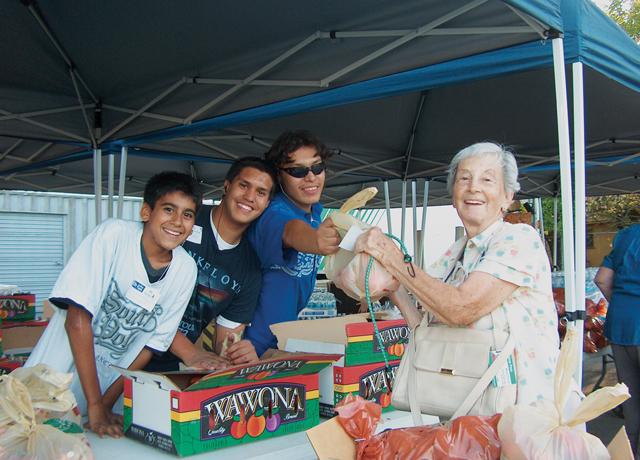
So if there’s a way to make good use of wasted food, especially if it’s free, much community impact can be made. Urban foraging (also called harvesting or gleaning), in a sense, is a food movement that can do more than motivate urbanites to cook with the rosemary growing along their sidewalk — it can save people. It puts waste to use. It makes us appreciate what’s right in front of us. It costs nothing. And it has helped revolutionize the way Sacramento feeds the hungry.
The Public Good
As a child at the dining table, my parents (like all parents) liked to say, “Eat your food; there are starving children in Africa.” This never made sense to me. How would a starving child in Africa be affected by my uneaten macaroni casserole?
Yes, my logic was naive. Yes, it missed the larger point. But it does cut to a sneakier truth about the problem of global hunger: It’s abstract. It often seems far away, and it’s disconnected from our day-to-day lives. There are no easy solutions.
And that’s exactly what makes urban foraging such a breakthrough: It actually is an easy solution. It connects the dots. While a kid can’t mail her meatloaf to Rwanda, it’s entirely possible — even easy — to collect a basket of ripe grapefruit and give them to people in need. Locally, most of the urban gleaning is focused on citrus; Allamano calls it “far and away the largest potential gleaning resource within Sacramento neighborhoods.”
About 13 years ago, Craig Diserens peeked over his fence and saw orange and grapefruit trees all around him. He realized that “within 100 feet from my house, there’s over 1,000 pounds of fruit a year.” He knew it could go somewhere useful. He first started picking the trees on his own, then he lassoed up a few volunteers, put a small blurb in a local paper and eventually developed an organization called Village Harvest, which donates more than 200,000 pounds of fruit to groups like the Food Bank of Yolo County.
Groups like Senior Gleaners and Harvest Sacramento embrace the same model. In 2013, hundreds of Harvest Sacramento volunteers picked 52,000 pounds of fruit from yards and orchards and delivered them to the Sacramento Food Bank. It’s a slick operation. You know how political campaigns use sophisticated, database-driven, get-out-the-vote machines? Soil Born does that with citrus picking. Allamano can tap into a database of trees, which lets him coordinate exactly which yards to hit to maximize the haul.
The volunteers are young, old, black, white, parents, kids, grandparents, 20-something do-gooders and a bike-riding 91-year-old who Allamano calls “the most vital person I saw all winter.” It brings the community together. “Sacramento turns out to be one of the most diverse cities in the United States, but people don’t spend a lot of time together. Food becomes the bridge through which that can happen.” These crates of plums and lemons eventually find their way to those who need them most. That alone is a win. But the produce does more than put food on empty plates: It’s helping to change the very dynamic of local food banks.
“About seven years ago, we changed our model. We felt there was a more dignified way that we could be serving families,” says Kelly Siefkin, communications and development director at Sacramento Food Bank & Family Services. The old model of a food bank, of course, is the gloomy sort of scene from Dickens (Please sir, I want some more). Processed food, long lines, grab and go. So the Sacramento Food Bank made a few changes to add some respect to the process. For starters, it switched the food pick-up hours from midday to evenings. This alone tripled attendance, since blue-collar workers tend to work from 9:00 to 5:00. The food bank also rearranged the pick-up location to feel more like a farmer’s market, with upbeat music, food tastings and nutritional seminars. Employees and volunteers recognized that an inner-city mother of five might not instinctively reach for a bag of pomegranates, so they now offer recipes, samples and easy techniques for using fresh produce to make nutritious meals. It makes those pomegranates, pomelos and beets all the more approachable.
On Saturdays families can enjoy a rural farmstand experience in
the city at Soil Born Farms’ American River Ranch.
(photo courtesy of Soil Born Farms)
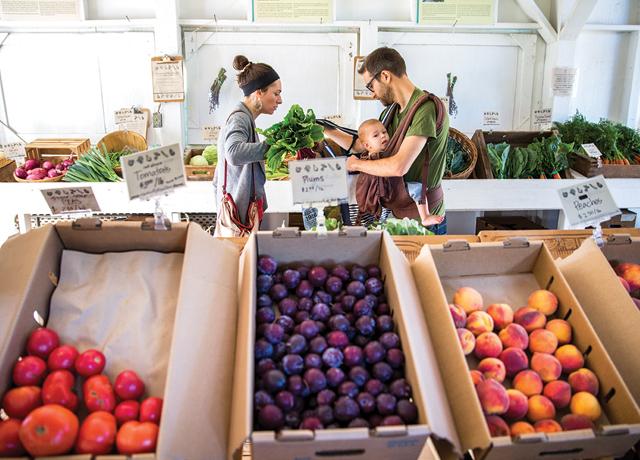
And for a struggling mom on food stamps, fresh grapefruit can feel like a massive splurge and as impractical as lobster. Donated produce fixes that. “A lot of families have come back and thanked us, saying that they’ve lowered their blood pressure and cholesterol, lowered their children’s weights and have more energy,” Siefkin says.
River City Food Bank has a similar story. Produce is more expensive for food banks to acquire than processed foods, so they view the foraged donations as critical. “There’s a certain amount of produce that we can’t afford to buy, and we depend on donations,” says Eileen Thomas, the program’s executive director. “These fill a huge niche in what we provide to our clients. It helps balance out the non-perishables.”
Back to the Land
Like most charitable activities, of course, there’s also a sneaky, selfish benefit. It feels good to donate. Or even if you’re picking the food just for yourself, there’s a satisfaction in knowing that you are eating from your own ecosystem. “When I’m walking around collecting food, I have a singular purpose,” says forager extraordinaire Hank Shaw. “Collecting walnuts. Looking for mushrooms. It’s a way for me to quiet the mind.”
Shaw isn’t a man who eats Frosted Flakes. He’s not big into canned peas. Instead, he feeds himself entirely off the land — nuts, fruits, berries, fish, wild game — and writes about it in books like Hunt, Gather, Cook: Finding the Forgotten Feast. When asked about the appeal of urban foraging, he says, “First of all, it’s right there. It’s literally the low-hanging fruit. In fact, in many cases, it’s not really foraging. It’s like, ‘Hey, there’s an apricot!’ They’re everywhere.”
Part of the allure is that it’s both obvious and somehow overlooked. “There are 20,000 cherry trees in the Sacramento area, and nobody knows about it. I’m eating a cherry plum right now,” he says. Shaw is amazed by how people breeze past the hundreds of fruit trees in plain sight, sometimes in their own yard. “Those burgundy-looking trees that they plant in parking lots? Those are plum trees, and nobody realizes it. I pick bushels of ‘em.”
Volunteers from Harvest Tahoe Park glean an old plum tree in a
neighborhood backyard.
(photo: Ken James)
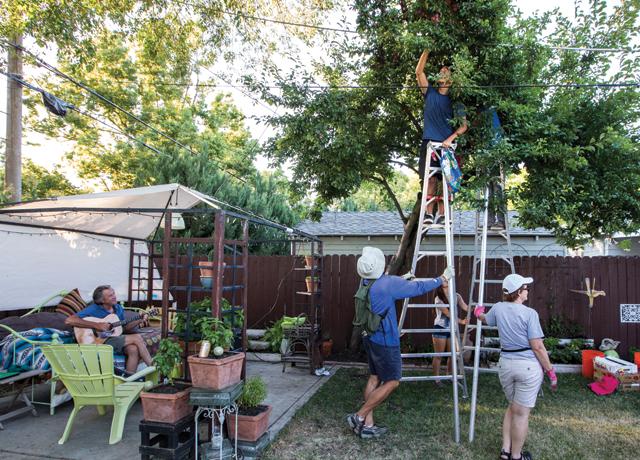
Scooping up oranges on a weekend gives you just enough exposure to nature without the hassle of, say, owning a farm. It’s the perfect way to date the earth without marrying it. The results are concrete, instantaneous and deeply satisfying. “It’s immediately tangible. It’s not a long-term project like building a computer system or writing a book,” says Diserens, an early pioneer of the movement and co-founder of Village Harvest. “You go out in the morning and see a single tree all loaded with fruit, and 15 minutes later, everything is off the tree and neatly stacked.”
Sometimes it’s easy to just grab a stray peach, and sometimes — especially for foodies who crave a challenge — the joy is in the hunt for the exotic. “Foraging for food is a little like a mythic quest,” writes Ava Chin in Eating Wildly: Foraging for Life, Love, and the Perfect Meal. “You may think you know what you want and expend a lot of energy making lists and plans for obtaining it … only to find it shimmering elsewhere, like a golden chalice, just out of reach.” (Pro tip: If you’re nervous about your ability to tell herbs from hemlock, you can cheat with smartphone apps like iPlant.)
So where do you start?
Just hop onto the Harvest Sacramento website and sign up, rookies welcome. On a typical Saturday morning, an average of 50 volunteers (and as many as 150) show up, are taught the basics and get divided into smaller teams of eight to 10 people. Or, if you want to go solo but aren’t sure where to begin, you can explore fallingfruit.org, a delightfully interactive, user-maintained map with one modest goal: charting every foraging spot in the world, from the black walnuts of Elk Grove to the ginkgo trees of Tokyo.
Make sure you abide by the foraging code: It’s generally OK to pick fruit on public land, but you can’t just brazenly walk onto a neighbor’s lawn and start picking her plums without asking. (Most people seem happy to oblige, as you’re basically just cleaning up what would otherwise be a rotten mess.) And if they don’t give permission … “The actual law is that if a part of the tree hangs over someone’s fence into the public sidewalk or street, you can pick that part,” Shaw says. He pauses, then adds, “There’s one pomegranate tree that hangs over a fence into a public park. I keep my eye on that tree.”
You can go this weekend. Or any weekend, as there’s something juicy to pick virtually every day of the year. “It’s a parade all the way until April, and the only real dry period is the beginning of May,” says Shaw. “Eleven months of the year, something is ripe.”
Allamano has a vision of urban foraging leading to something even larger. Centuries ago, most citizens used land for something useful. Gardens gave us vegetables; trees gave us fruit. Now? In subdivision after subdivision across America, front lawns are nothing more than pastoral fashion statements, symbols that we’re keeping up with the Joneses. “Almost everyone’s landscape is decorative,” Allamano says. “It doesn’t provide a good habitat, doesn’t provide food, doesn’t do much of anything except consume a lot of resources and water.”
Urban harvesting is a way to change that cycle. “People are hungry for more purpose, more connection,” he says. “Urban harvesting does this. With the farm-to-fork movement, there’s an identity shift in Sacramento. People are embracing that role, and we’re trying to give that a voice.”
Where do you forage? Let us know in the comments!
Recommended For You
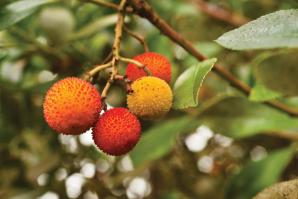
Coming to a Sidewalk Near You
The one-stop resource for gleaning food from your own neighborhood
Thousands of pounds of urban produce are growing on trees and bushes all around you, and if you know where to look, you can gather enough fruits and vegetables to stock a food bank, plan a dinner menu and can a dozen jars of organic blackberry preserves.
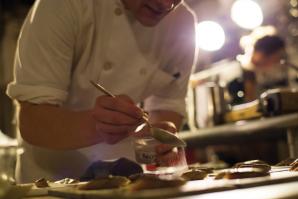
Naturalist Nouvelle
Unearthing a new restaurant concept
Six months ago, Kevin O’Connor hit a wall. He had a good job in a good kitchen, but his body was exhausted and his passion was gone. So, at 24, he decided to step down as the chef of the now-shuttered Blackbird Kitchen & Bar and dig for a new plan.
Sacramento Food Bank & Family Services
Learn more about SFBFS’s mission, and how you can help.
River City Food Bank
Learn more about River City Food Bank’s mission, and how you can help.



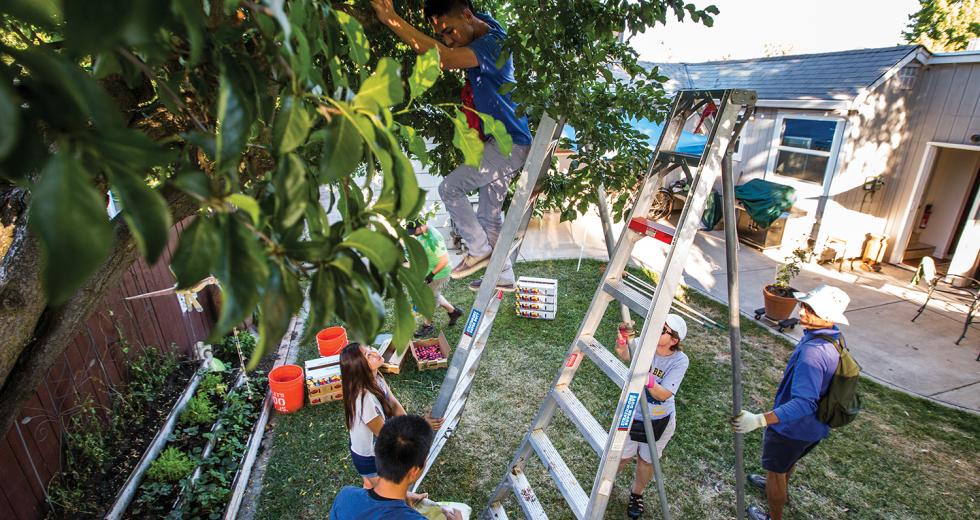
Comments
There is a row of elephant heart and Santa Rosa plum trees in Loomis that I discovered 3 years ago that goes untouched. Around 20 trees. Plum jelly for days and days. And all those cherry plums make syrup for ice cream.